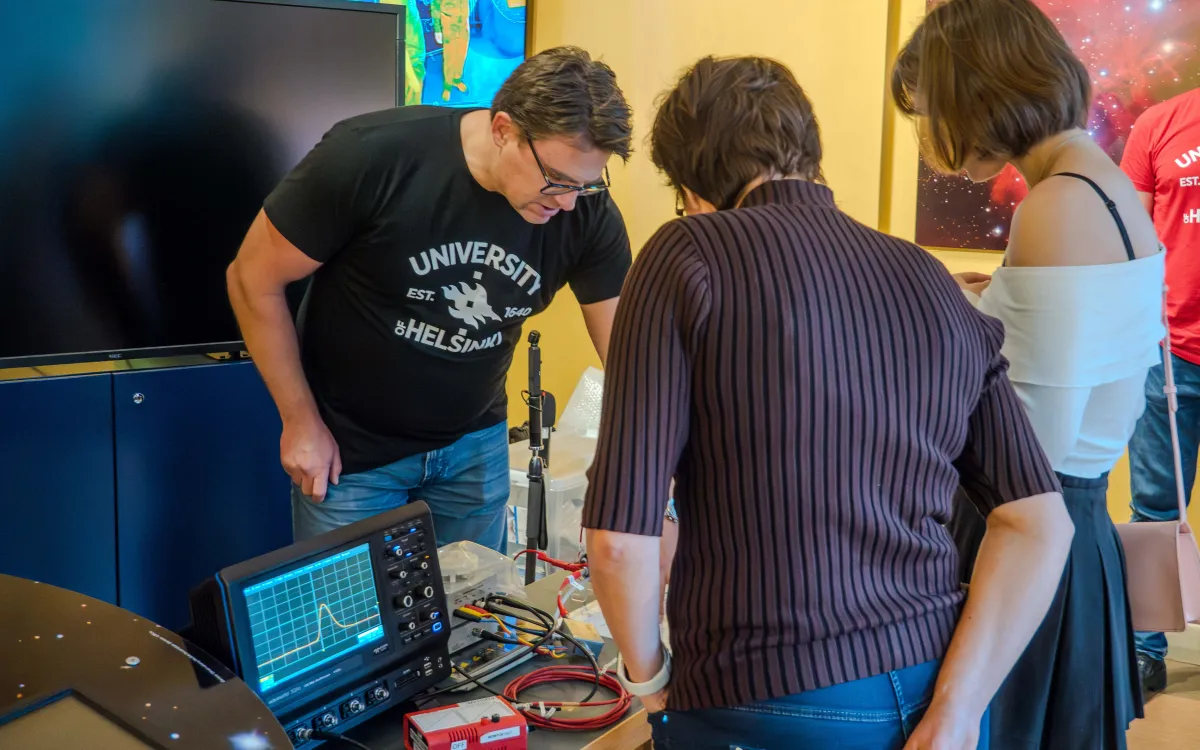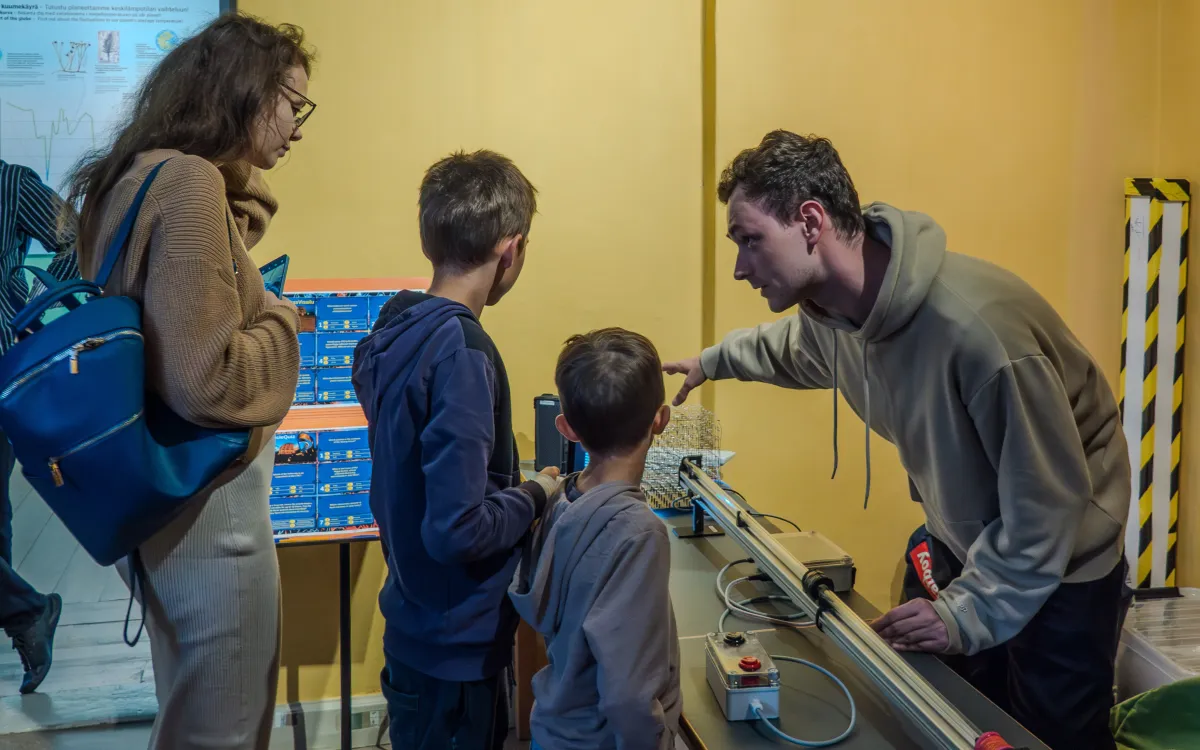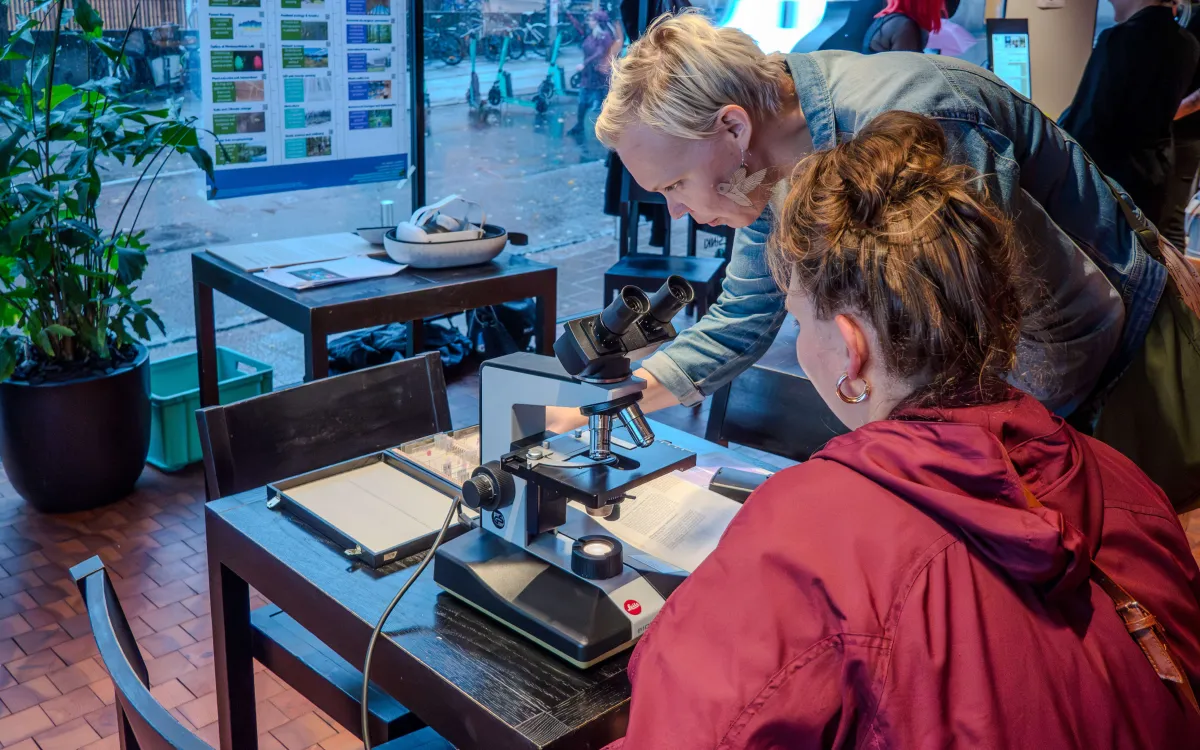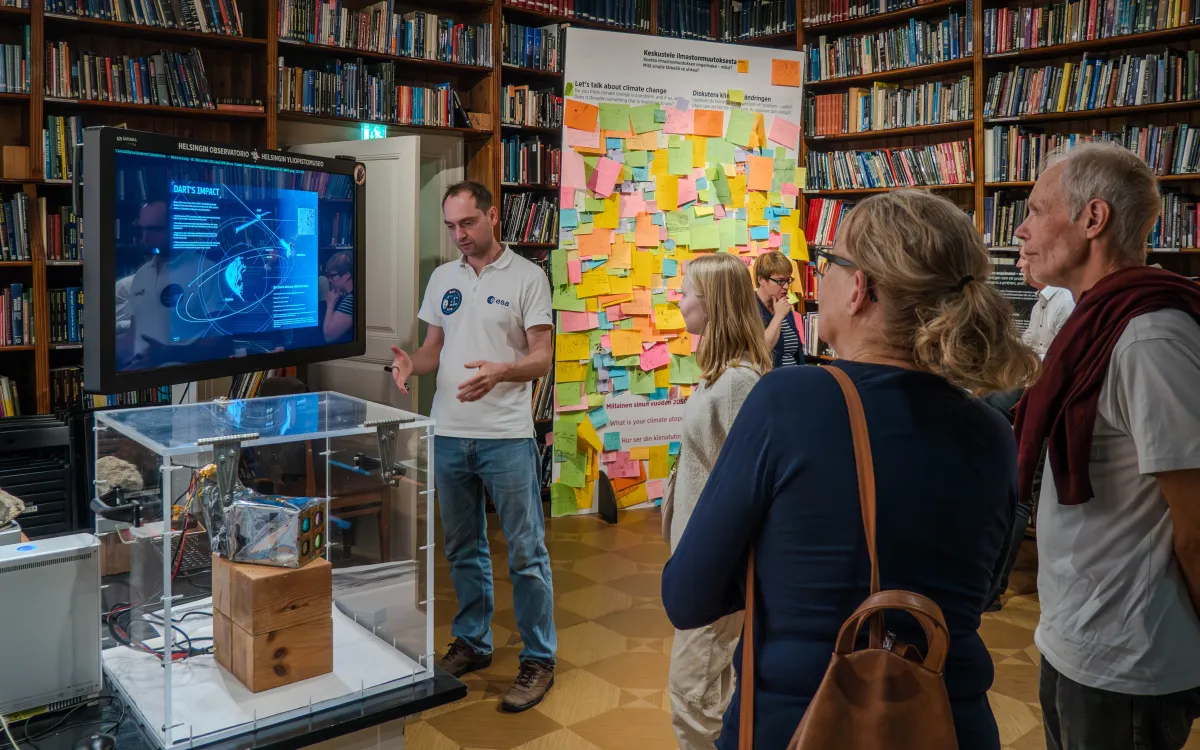Researchers night
Researchers’ Night is an annual science event where researchers across Europe open their doors to curious minds of all ages. This all-day and evening event celebrates the achievements of science and research through a multidisciplinary programme. Researchers present their work and studies through workshops presentations, lectures, and lab visits.
During the day, children and young people can explore researchers’ work and university facilities in workshops held on University of Helsinki campuses. The workshops are free of charge.
There are more workshops in Finnish site that are only in Finnish.
From Sun to Earth: The Journey of Solar Storms
Organiser: Space Physics Research Group
Description: A short presentation and interactive activities tailored to the age of the registered group.
Place: Physicum, Kumpula campus (Gustaf Hällströminkatu 2)
Time: 10:00 - 11:00, two parallel groups
Target group: Kindergarten, Primary school grades 1-3. Primary school grades 4.-6. Secondary school, Upper secondary school.
Duration: 60 min
Group size: max 30
Cycling in a virtual reality city
Organiser: Digital Geography Lab
Description: In the workshop, you will explore how virtual reality (VR) can be used in urban research and experience different digital scenarios in varying urban nature and seasons. The workshop includes a short introduction to virtual reality research and the equipment used, after which groups will get to try VR cycling themselves. The workshop can be arranged in Finnish and English. They are fun and safe, and no prior experience with virtual reality or cycling is required.
Place: Physicum, Kumpula campus (Gustaf Hällströminkatu 2)
Time: 9.00–10.00, 10.30–11.30, 13.00–14.00 and 14.30–15.30
Target group: Secondary school, Upper secondary school
Duration: 60 min
Group size: max 10
In the evening, anyone can dive into the fascinating world of science through activities led by researchers at the Observatory 17-20 and at Think Corner 16-20. There will also be activities at Kallio tapahtumalava from 17-19.
The Observatory’s permanent exhibition also invites you to explore the mysteries of the universe.
Addresses:
Kopernikuksentie 1, Helsinki (Observatory)
Yliopistonkatu 4, Helsinki (Think Corner)
Viides linja 11, Helsinki (Kallion tapahtumalava)
The Observatory and Think Corner programmes, as well as the Observatory exhibitions, are open to everyone and free of charge during Researchers’ Night, with no registration required.
Social Psychology and Virtual Reality
Organisers: Equality through Research and Art in VR research group. Inga Jasinskaja-Lahti, Matilde Tassinari, and Reko Elovainio.
Description: An engaging and informative stand where visitors can explore virtual environments and interact with diverse virtual characters—people they might not encounter in everyday life. Our aim is to introduce and promote our ongoing research on virtual reality and its applications in social psychology. We want to demonstrate in a clear and accessible way how VR can be a powerful tool for understanding human behavior, ultimately contributing to a better world. Activities at the Display Stand include Informative reading materials, short videos related to our research and virtual reality headsets for hands-on experiences. Workshop is available in English and in Finnish.
GREENTRAVEL – Greener Urban Travel Environments for Everyone From Measured Wellbeing Impacts to Big Data Analytics
Organiser: Digital Geography Lab. Dr. Milad Malekzadeh and Robert Klein
Description: The GREENTRAVEL Project aims to leverage recent developments in urban informatics to produce novel understandings on the importance, availability and wellbeing impacts of urban travel greenery experienced by people in their everyday active travel environments. Furthermore, it will produce new knowledge on how equitably green exposure during travel and related wellbeing impacts are available to urban populations. It shall leverage this knowledge to develop new analyses and approaches to add greenery in urban travel environments to advance equity in European cities.
In our stand, we will present posters providing an overview of the GREENTRAVEL project as well as insights from ongoing research and innovation (e.g. the use of AI to assess urban attractiveness, computational large-scale measurements of street greenery from human perspectives, temporal and seasonal variations in street greenery across European cities). Members of the GREENTRAVEL research team will be present in person to present and discuss the project, their active research as well as address any questions.
Climate Puzzle
Organizer: Helsinki Institute of Sustainability Science (HELSUS). Michael Lettermeier
Description: The Climate Puzzle is an educational and planning game that brings climate research results to everyday actions. The game illustrates how our lifestyle need to change to mitigate climate change. It also guides participants to consider how societal actors can support the transition towards a low-carbon life. This game is suitable for both young people and adults.
Mathematics behind images
Organizer: Finnish Inverse Problems Society (FIPS) & Centre of Excellence in Inverse Modelling and Imaging (FAME). Saara Malila, Alexander Meaney, and Markus Juvonen
Description: We present the mathematics behind photographs and X-ray tomography. The aim is to show the math underlying different types of images and explain the research conducted in our group and at FIPS/FAME. Participants can contribute to image quality research by comparing images at our stand. You will also be introduced to the world of X-ray and tomographic imaging. The stand features a live demonstration of the time derivative of a live video feed.
Mammal Fossils, Early Humans, and Ancient Climates – Paleontology and Paleoclimatology Research in Helsinki
Organizer: Evolutionary Paleontology, Hominin Ecology, and Paleoclimatology research groups. Juha Saarinen, Sakari Salonen, and Miikka Tallavaara
Description: Explore fossils, stone tools, and discuss the history of life and climate with experts. What can fossil mammal teeth tell us about changes in Earth's environments over time? What were Earth's climates like thousands or millions of years ago? What do we know about early humans and how did our species come to dominate the planet? At our stand, you can explore these questions and climate history with specialists from the University of Helsinki.
Climate Change, Biodiversity Loss, and Future Forests
Organizer: Faculty of Agriculture and Forestry
Description: How will climate change and the loss of biodiversity affect the forests, the carbon assimilation of forests, and the organisms living in them? Further, will the use of wood as part of sustainable building have any impact on the well-being experienced and measured in humans? What kind of tools are currently used to measure forests and what will they be like in future? At this stand you will be able to take methane and carbon dioxide measurements, hug different kinds of trees, and find out which is your favorite kind of tree. You will also be able to look at the light produced by tree leaves, which is invisible to the human eye, and which gives us an indication of how the tree is doing. We also have information on various forest insects and their secret social life, looking at insects through a microscope, learning to identify where insects have been feeding, and a detective assignment where you can learn about the color vision and behavior of pollinating insects with the help of UV lamps. These activities are suited both for children and adults.
Cartographic and Other Geomedia Skills in Today’s Media Environment
Organizer: CRITICAL project. Petteri Muukkonen and Laura Hynynen
Description: At this stand we will explore maps, geographic diagrams, and images in today’s media landscape and how to interpret them. Through exercises and media analysis, you’ll get hands-on experience with geomedia in news. Participants can also test their skills in interpreting geographic media through quiz.
Modelling the Universe from Galaxies to Black Holes
Organisers: Alex Rawlings, Toni Tuominen, Till Sawala.
Description: to present and highlight results of recent and ongoing work by the Helsinki theoretical astrophysics group.Simulation visualisations from the Helsinki Theoretical Extragalactic Research Group. How do galaxies look at different wavelengths? Interactive experiment: will the Milky Way collide with Andromeda?
From Tiny Particles to Big Questions – A Journey into the Heart of Physics
Organizer: Helsinki Institute of Physics (HIP)
Description:From particle detectors to cosmological models – come explore the research and activities of the Helsinki Institute of Physics. The goal of the stand is to show HIP’s research. Various detectors used for measuring radiation is on display. For example visitors can try out a metal ball accelerator powered by electromagnets and learn about detecting cosmic radiation. You can also ask theoretical physicists topics such as dark matter and the structure of the universe.
HIPScapeRoom – A High-Energy Physics Escape Room
Organizer: Helsinki Institute of Physics (HIP)
Description: You have about half an hour to escape the snares of high-energy physics. Max 10 persons per session, sign up the same night by the entrance to the escape room at the Observatory.
Seismology Info Stand
Organizer: Institute of Seismology
Description: Earthquakes in Finland? Did you know that dozens of earthquakes occur in Finland each year? Though they are low in magnitude, the Institute of Seismology receives observation reports. Seismic measurements in Finland began in 1924, when the first seismograph was installed in the basement of the University of Helsinki’s Department of Physics. While natural seismic activity is not a major societal concern in Finland, seismic measurements have important applications. These include assessing seismic risks at nuclear power plants, studying earthquake occurrences in bedrock, identifying seismically active areas, and contributing to global nuclear test monitoring. Warm welcome to come to the Institute of Seismology's stand learn about the history of seismic measurements and future research directions in seismology.
Urban placemaking and young people's geographies
Place: Kallion tapahtumalava, next to Kallio Library (Viides linja 11), 17:00–19:00
Organiser: The Affective Geographies & Politics of Education research group
Description: During the evening, you’ll meet our researchers to discuss their work on geography education, young people’s geographies, urban placemaking, experimental learning, and non-representational, more-than-human approaches to the city. In addition to presentations and discussions we’ll offer hands-on activities, including experimenting with an interactive artwork made by young co-creators (aged 9–12) that guides you to explore the city through more-than-human perspectives. Participants are also invited to share their insights by writing or drawing their reflections on the communal art wall created by upper-secondary school students at the event stage. You can engage with the researchers in Finnish, Swedish, and English.
During the European Researchers' Night, entry to the Science Museum Flame exhibition centre is free at 16-20.
Have you already visited the exhibitions at the Science Museum Flame? The Food for All exhibition explores topics that touch all our daily lives: How has science influenced what we eat? Where does our food come from? The exhibition serves up a generous portion of the history of science, seasoned with a touch of humor. It also invites you to reflect on your own views about food.
The permanent Passion for knowledge exhibition introduces stories from the University of Helsinki and the people who have worked there. What kinds of places is research conducted in, and how have different fields of science shaped the development of Finland?
Address: Fabianinkatu 33, entry via Yliopistonkatu 2.



